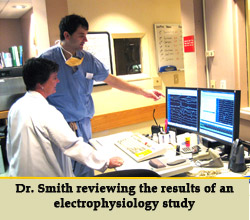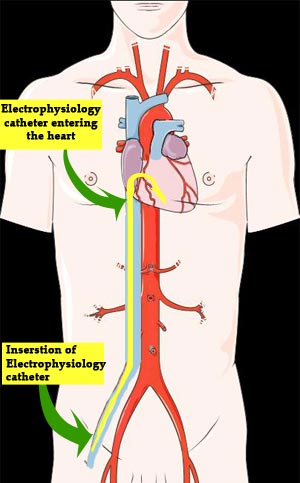 Electrophysiology is the study of the electrical system of the heart which controls the heart rhythm. Abnormal rhythms can be either slow or fast and can manifest themselves as lightheadedness or palpitations respectively. Sometimes the patient may need a pacemaker for a slow heart rate or a defibrillator if there are life-threatening fast heart rates. In certain cases the diagnosis is not clear and an Electrophysiology Study is needed. In this procedure small (<2mm) plastic tubes (“catheters”) are placed into the heart to help look for abnormalities in the heart’s electrical system. By stimulating the heart, these special catheters are able to map the heart’s electrical system and can sometimes reproduce the abnormal heart rhythm so that it can be studied in a controlled fashion.
Electrophysiology is the study of the electrical system of the heart which controls the heart rhythm. Abnormal rhythms can be either slow or fast and can manifest themselves as lightheadedness or palpitations respectively. Sometimes the patient may need a pacemaker for a slow heart rate or a defibrillator if there are life-threatening fast heart rates. In certain cases the diagnosis is not clear and an Electrophysiology Study is needed. In this procedure small (<2mm) plastic tubes (“catheters”) are placed into the heart to help look for abnormalities in the heart’s electrical system. By stimulating the heart, these special catheters are able to map the heart’s electrical system and can sometimes reproduce the abnormal heart rhythm so that it can be studied in a controlled fashion.
Certain fast rhythms such as supraventricular tachycardia (SVT), atrial Flutter and some cases of atrial Fibrillation can be treated with catheters thereby reducing or eliminating the need for medications. After the electrical system is mapped with catheters, an ablation procedure is performed where the rhythm is eliminated by using special catheters that deliver radiofrequency to burn small areas of the heart or other catheters which freeze these areas.
 From a patient perspective, the procedure may feel very similar to the more common, cardiac catheterization procedure. Unlike a cardiac catheterization, no dye, “contrast,” is used and bleeding complications are less common since most procedures are performed through veins, not arteries. Similar to a cardiac catheterization, it is performed under local anesthesia with mild to moderate sedation but not general anesthesia. (General anesthesia will increase the risk for complications with the procedure).The patient is then placed on a table in the electrophysiology lab and local anesthesia is administered through a small small needle to the access site which is typically the top of the right leg. A tiny incision is made to access the femoral vein (the artery less commonly) and a small (<2mm in diameter) plastic tube (“catheter”) is inserted up through the vein in the leg into the heart. The patient typically feels a light pushing at the top of the leg as the catheter is manipulated at the access site. The patient may also feel the heart racing as the cardiologist maps the electrical system. The results of the procedure are known immediately and will be discussed with the patient and family shortly afterwards.
From a patient perspective, the procedure may feel very similar to the more common, cardiac catheterization procedure. Unlike a cardiac catheterization, no dye, “contrast,” is used and bleeding complications are less common since most procedures are performed through veins, not arteries. Similar to a cardiac catheterization, it is performed under local anesthesia with mild to moderate sedation but not general anesthesia. (General anesthesia will increase the risk for complications with the procedure).The patient is then placed on a table in the electrophysiology lab and local anesthesia is administered through a small small needle to the access site which is typically the top of the right leg. A tiny incision is made to access the femoral vein (the artery less commonly) and a small (<2mm in diameter) plastic tube (“catheter”) is inserted up through the vein in the leg into the heart. The patient typically feels a light pushing at the top of the leg as the catheter is manipulated at the access site. The patient may also feel the heart racing as the cardiologist maps the electrical system. The results of the procedure are known immediately and will be discussed with the patient and family shortly afterwards.
In 2007, Merrimack Valley Cardiology became the only cardiology group in the area that specializes in placing and managing these devices. By developing a local electrophysiology program, we are bringing these increasingly common and safe procedures to the community and improve the overall cardiovascular care of our patients.
What to Expect Before the Procedure:
- Nothing to eat after the midnight before the procedure.
- You may take your pills with small sips of water.
- Diabetes pills should be held and if you take insulin, ask your physician how the dose should be adjusted.
- If you take Coumadin, aspirin or Plavix, please ask your cardiologist if these should be withheld before the procedure.
- You may bring a CD of your favorite music to help you relax.
What to Expect After the Procedure:
- There may be soreness at the incision site and possibly some swelling and bruising.
- There may be a small, walnut-sized lump at the access site which should become smaller and becomes less tender within days.
- There may be a small area of bruising following the procedure which may seem to get larger and expand down the leg. This is often seen and does not typically represent ongoing bleeding but often represents old blood under the skin which is traveling in the direction of gravity.
- Avoid any significant physical activity or heavy lifting for the first few days after the procedure.
- The patient may resume driving the day following the procedure.
- Avoid taking a bath for a few days; showers may be taken within 24 hours.
When to Call your Physician or 9-1-1:
- Bleeding at the access site. Pressure should be applied to the site by a friend/family member until medical advice is obtained.
- Severe tenderness, discharge or fever.
Complications:
Complications of the procedure are rare but could include a blood vessel tear or bleeding, or very rarely stroke or heart attack. Life-threatening complications are extremely rare.
For more information about Pacemakers, click here.
